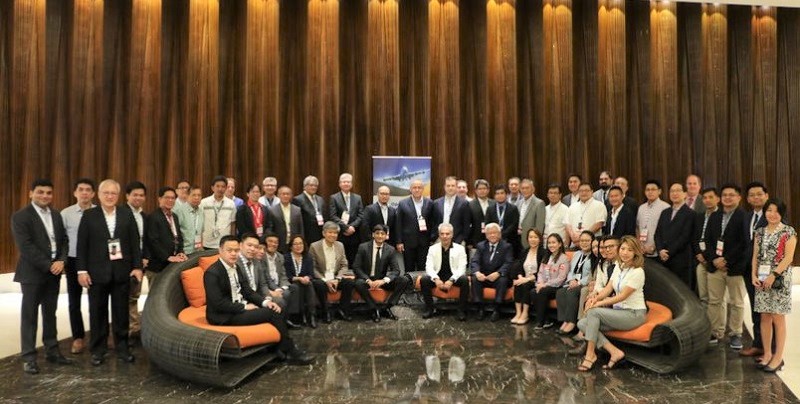
On 27th June 2019, senior executives from the Philippine aviation and airport sector gathered for an insightful discussion on the airports of the future and how the future of air transport will be driven by digital transformation.
OpenGov Asia’s Breakfast Insight: Future Airports – Taking Off with Digital Transformation gave delegates the opportunity to discuss key issues surrounding the future of air transport and the benefits of implementing smart technology. Key pillars such as people, process and technology as well as the challenges and the best way for IT leaders to respond to this demand were deliberated.

Mohit Sagar, Group Managing Director and Editor-in-Chief of OpenGov Asia, set the tone of the day.
His premise was technology is the enabler of digital transformation. Further, people with an open mind, willing to explore new technology and new methodology are the key to digital transformation.
Such transformation will be able to deliver flexible, agile, and on-demand access to services. Given the speed with which citizens are becoming digital-natives and their current expectations, they would demand nothing less.

Sumesh Patel, President – Asia Pacific, SITA, created the context for discussion by highlighting the importance of collaboration.
He was of the firm belief that all stakeholders should work together – governments, airports and airlines – in order to provide services with value to the passengers.
Collaboration is critical to the success of the aviation industry. Cooperation and feedback create synergy that allows for growth, development and effectiveness.
Mobility and Connectivity

Taking the discussion forward was Captain Jim C. Sydiongco, Director General, Civil Aviation Authority of the Philippines, He delivered the keynote address that highlighted the main objective of the Department of Transportation: Make the Filipino life Comfortable.
This aim, according to him, translates to having enhanced mobility and connectivity for the Filipino people.
While this may come with difficulties and challenges, particularly since the Philippines is an archipelago, they have proven through some of their recent initiatives that the Philippine Aviation is ready for take-off.
Captain Jim shared that airport infrastructure projects are underway; new airports are being built and existing ones are being upgraded and rehabilitated.
He cited several Philippine airports as examples that underscored his stance – Bohol-Panglao International Airport, Bicol International Airport, Mactan-Cebu International Airport, Puerto Princesa International Airport and Clark International Airport to name a few.
Furthermore, a recently inaugurated Communications, Navigation, Surveillance/Air Traffic Management system now makes airspace safer, minimises flight delays and improves overall travel experience.
Captain Jim concluded his speech by saying, “As we move towards a new chapter, we take to heart that by developing our airport infrastructures and services, we are enhancing connectivity and mobility for the Filipino people and our foreign guests. These, coupled with digital transformation will holistically connect our archipelago and open our country to the rest of the world more efficiently and effectively.”
Mumbai International Airport Ltd.: A Case Study

International expert speaker, Rajgopal Narayanan, Senior Manager Business Development, SITA, Implementor/Former GM-Joint Control Centre Operations, Mumbai International Airport Ltd., shared the airport’s monumental digital transformation journey to improve reputation, attractiveness, and passenger experience.
Raj began his speech describing the Philippines as having a commonality with India. He then asked, “Does the airport reflect the image of the city?”
Mumbai is the wealthiest city in India, with the highest number of millionaires and billionaires among all cities in the country.
It serves as the financial and commercial capital of India. Migrants are attracted because of this, as well as its business opportunities and potential to offer a higher standard of living, thereby making the city a melting pot of many communities and cultures.
However, Mumbai’s Air Transport Sector was not commensurate with the image of financial and economic success in the year 2000.
Challenges at Mumbai Airport before 2005
The airport received criticisms for its shoddy passenger facilities, and connectivity. Even the former Chief Minister of Maharashtra, Mr Sharad Pawar, likened Mumbai Airport to a bus stand.
Raj listed the key challenges at Mumbai Airport:
- Long waiting queues for Entry into the Terminal.
- Congestion at key check-points such as check-in counters, among others
- Immigration facilities
- Cleanliness and hygiene
- Terminal capacity vs. actual movement
- Airside demographics
- Air Traffic Systems
- Unpredictable aircraft holding times
- Restriction in air routes
- Cross Run-way capability
- Slots and Seat Share factors
Reforms by the Government
To address the problem, the Government allowed private players in the infrastructure sector, which included public-private participation in the construction and operation of India’s airports.
The Government had two key transition objectives: World Class Development and Expansion and World Class Airport Management.
After sharing this, Raj went on to share the major focus reforms initiated by the Indian Aviation Ministry. These are:
- Regulatory Standards and licensing
- Airport Infrastructure and services
- Security Standards and Compliance
- Air Traffic Control
- Air Transport Services
- Refuellers
- Ground Handling Companies
- Customs & Immigrations
- Plant & Animal Quarantine
- Revenue Model – Concessionaires/Car Park services.
Comparing Mumbai with the Philippines
Raj began his talk by stating that there are commonalities between India and the Philippines. He ended it by comparing them.
The similarities are:
- Long waiting queues for Entry into the Terminal.
- Congestion at key check-points such as check-in counters
- Immigration facilities
- Cleanliness and hygiene
- Terminal capacity vs. actual movement
- Airside demographics
- Air Traffic Systems
- Unpredictable aircraft holding times
- Restriction in air routes
- Cross Run-way capability
- Slots and Seat Share factors
He concluded by sharing that the air transport sector makes a major contribution to the Philippine economy.
Delegates of the OpenGov Breakfast Insight: Future Airports – Taking Off with Digital Transformation left the session with a far more comprehensive and pragmatic understanding of digital transformation in airports. The genuine sharing of real journeys, robust discussions and insightful interactions provided not only food for thought but a better idea for a way forward.
















